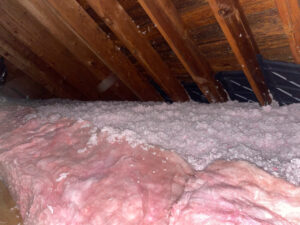
The attic can mean different things to different people. Maybe you store boxes of holiday decorations or tubs of items you have yet to unpack. Maybe it has no insulation and you use it as an extra room. Maybe it is the place you’ve never stuck your head into and never will! Regardless of your attic status at home, it is the most significant part of the home in terms of controlling the loss of treated air. And when you’re losing heat, you’re losing money. This article will explain why an even distribution of insulation is so important and what the impact gaps have on the entire home.
Insulation is made to slow and retain heat loss in the home during the winter, as well as block out heat during the summer. Other parts of the home contribute to overall heat loss, but the tendency for hot air to rise makes the attic especially important. Around 25-35% of heat loss in the home can be attributed to the attic. The effectiveness of insulation is measured by the R-value. R-values fluctuate depending on where you live; the DMV region is in zone four and must meet R-49. To reach R-49, that can mean 17 inches of fiberglass, 16 inches of fiberglass batts, or 15 inches of cellulose depending on the type of insulation in use. Insulation installation should be installed only after air sealing and ventilation is addressed in the attic to ensure it performs efficiently. Otherwise, you’ll end up with more problems than when you started. By the way, storing items in the attic and simultaneously having a fully insulated attic is possible. Raised platforms are a great option that won’t compromise the effectiveness of insulation. They can be built as a path down the middle of the attic or just a sectional piece.
When attic insulation is installed, it needs to be distributed evenly like a blanket on a flatbed. That is one advantage to using blown insulation as opposed to batts. Blown insulation with the right tools and equipment fill all of the hard to reach spots without having to bend backwards trying to place installation correctly. When installation is done improperly, the effective R-value of the entire attic can drop dramatically. For example, if you install 12 inches of fiberglass batts with 2.5% of the total floor area having gaps, the R-value of the attic goes from 30 to 22. If there’s 5% gaps, it goes from 30 to 8.5. That’s a lot of money spent on ineffective insulation, ensuring that you’ll continue to have drafty and uncomfortable rooms.
Whatever the use of your attic is, evenly distributed insulation is a necessary part. It is the most effective tool we have to retain heat in the winter and keep heat out in the summer. An energy audit is a good starting point if you are considering a project like this. The audit team can walk you through a list of benefits like the energy savings, payback period, and eligible rebates. Just as importantly, the team will recommend appropriate air sealing and ventilation measures to ensure insulation lasts its entire lifespan without moisture and other outdoor element issues.





